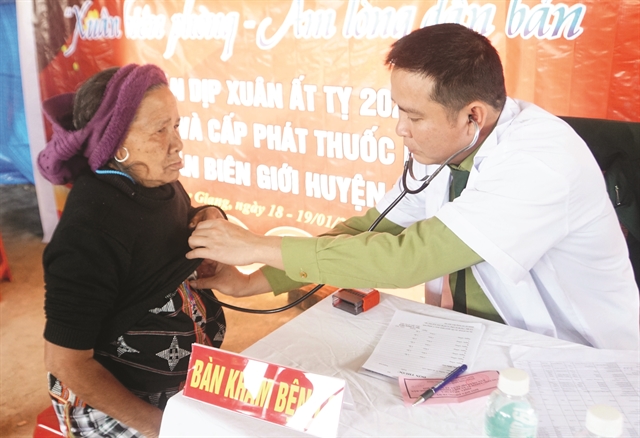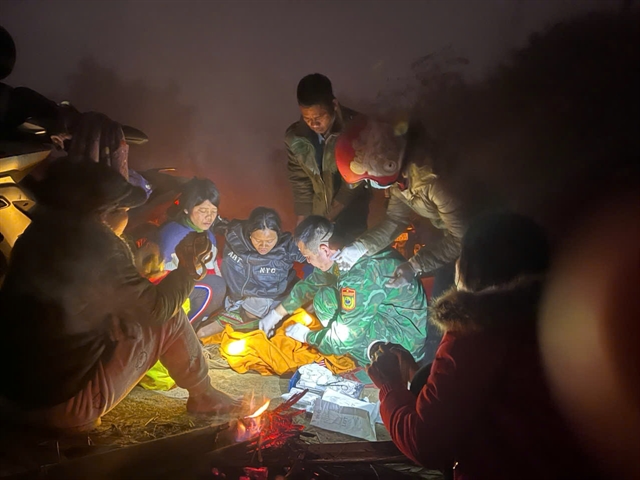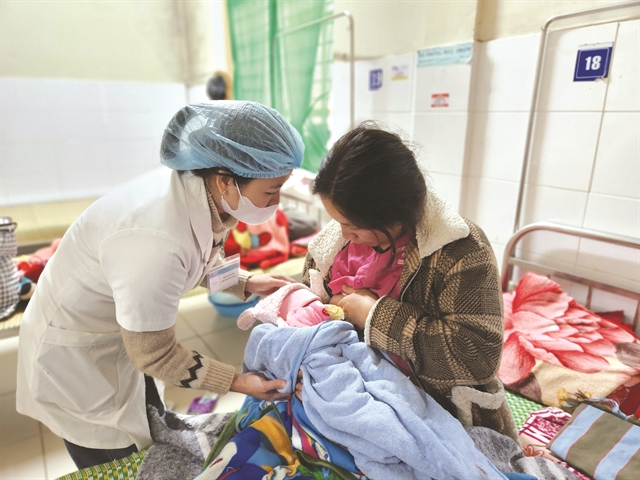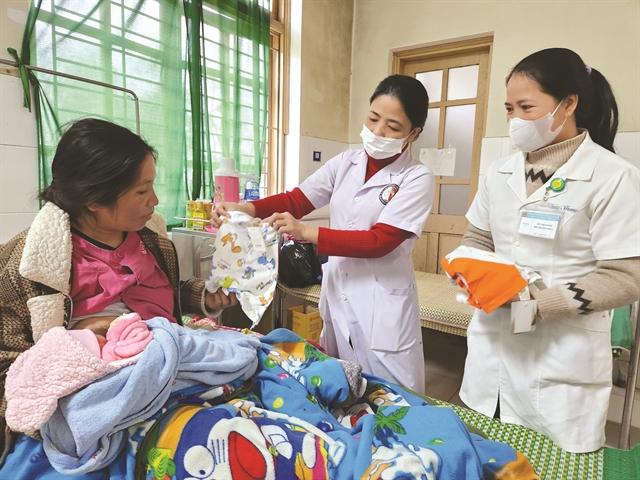 Society
Society
.jpg)
 |
| Doctor Nguyễn Văn Quốc Trí gives a health check for an ethnic minority woman in Tây Giang District, Quảng Nam Province, in early 2025. VNA/VNS Photo. |
By Thu Vân & Mai Trang
Along the rugged borderlands of Việt Nam and Laos, where mountains form natural barriers and villages remain isolated by difficult terrain, access to healthcare is a daily struggle. In these remote regions, medical workers—both civilian and military—are working tirelessly to bridge the healthcare gap, bringing much-needed treatment and hope to communities on both sides of the border.
Whether through the unwavering dedication of military medics in Quảng Nam’s Tây Giang District or the compassionate care of doctors at the A Lưới District Medical Centre in Thừa Thiên Huế, these efforts are reshaping healthcare accessibility for ethnic minorities and strengthening the deep-rooted ties between Việt Nam and Laos.
A lifeline in border district
At around 4am on January 27, 2024, in the biting cold of winter, Nguyễn Văn Quốc Trí’s phone rang. On the other end was the panicked voice of the husband of Bríu Thị Poi, a 29-year-old ethnic Cơ Tu woman in Arooi Village, Ga Ry Commune. His wife had gone into labour en route to the clinic but had suddenly experienced a violent contraction, her water breaking mid-journey. Unable to continue on the motorbike, she was stranded at the edge of the forest.
As soon as the call ended, Trí grabbed his emergency medical bag and set off with his colleagues.
 |
| Dr Nguyễn Văn Quốc Trí and his team assisted a pregnant woman in delivering her baby at midnight on the edge of the forest. Photo courtesy of Nguyễn Văn Quốc Trí. |
A doctor at the A Xan Military-Civilian Clinic in Tây Giang District since 2014, Trí has been responsible for providing healthcare to residents of four highland border communes—Gari, Ch’ơm, A Xan, and Tr’Hy.
In reality, the clinic serves not only Vietnamese citizens but also Laotian residents from border villages such as Keo, Tà Vàng, A Chinh, and Chi Tơ in K’Lừm District, Sekong Province, who frequently seek medical care from the Vietnamese border guards.
Navigating through the dense, misty darkness, they searched carefully for a safe path. Upon reaching Ganil Village in A Xan Commune, about five kilometres from the commune centre, they found the woman’s anxious family waiting. The moment they recognised Dr Trí, hope flickered in their eyes before erupting into overwhelming relief.
“In the eerie darkness of the mountains, the woman sat in agony by a narrow dirt path, clutching her husband's hand and looking at me as if pleading for help. I quickly reassured them and instructed her family and officers from the A Xan Border Guard Station to collect wood to make a fire for warmth and use torches to illuminate the area for the delivery,” Dr Trí recounted.
After relentless efforts, a healthy baby girl was born. Her first cries echoed through the ancient forest at the break of a freezing dawn. Once the umbilical cord was cut, both mother and child were transported to the clinic for further care.
At 20, Trí, a native of Tam Hiệp Commune, Núi Thành District in Quảng Nam, enlisted in the province's Border Guard. In 2007, after graduating from a military medical school, Warrant Officer Trí was assigned to the A Xan Border Guard Station.
Four years into his service in the remote forests, he witnessed the immense hardships local people faced, particularly in healthcare. As a medic, he could only treat common illnesses, which left him feeling limited in how much he could help.
Determined to do more, he submitted a request to the Quảng Nam Border Guard Command, seeking permission to study at the Huế University of Medicine while covering his own tuition fees. After four years of dedicated study, Dr Trí was reassigned to the Đăk Pring Border Guard Station in Đăk Pring Commune in Nam Giang District.
In 2014, he returned to A Xan to take charge of the A Xan Military-Civilian Medical Clinic.
Though designated as a clinic, the facility is equipped with modern medical devices, allowing Dr Trí to handle complex cases.
Deputy Political Commissar of the A Xan Border Guard Station, Major Phan Minh Xuân, praised Trí’s commitment:
“Dr Nguyễn Văn Quốc Trí is not only highly skilled but also deeply dedicated. Alongside treating patients, he actively encourages local people to adopt a healthy lifestyle. His words carry great weight in the community because they are always backed by action. For us border guards, earning the people's trust and support is vital to safeguarding national sovereignty and security.”
To build trust with the local community, Dr Trí took the initiative to learn the Cơ Tu language, allowing him to communicate more effectively with patients. When language ceases to be a barrier, so does the distance between doctor and patient.
Through his dedication and sincerity, Dr Trí has not only strengthened the bond between border guards and local communities but has also deepened trust in the mission of those safeguarding the frontier.
For many, the clinic has become a beacon of hope. Sut Nhon, a resident of Kà Lừm District in Laos, is among those who regularly seek treatment there.
“Whenever I come here, the doctors take excellent care of me, and my condition improves significantly. This clinic has become a trusted healthcare provider for people in the border villages of both Việt Nam and Laos,” he said.
Bling Mơ, a resident of Tr’hy Commune, recalled that in the past, people in the four communes of A Xan, Tr’hy, Gary, and Ch’ơm turned to shamans rather than visiting healthcare facilities.
“Since the A Xan Military-Civilian General Clinic was established and dedicated medical workers like Dr Trí arrived, our people have had much better access to healthcare,” he said.
“Dr Trí wouldn’t hesitate to walk long distances, even at night, to reach patients’ homes—especially those who couldn’t afford to go to the hospital,” Mơ added.
Compassion knows no borders
Even as the chill of the Trường Sơn mountains deepened at the end of 2024, the compassion at the A Lưới District Medical Centre brought warmth to many hearts.
Beside Hồ Văn Pếp's and Quỳnh Thiệu’s hospital beds sat large bags filled with warm clothing—carefully chosen from the centre’s charity wardrobe, which bears the message: “Take what you need, give what you can.”
Beaming with joy, Pếp eagerly displayed the clothes he had picked out for his grandchildren.
For patients like Lê Thị Nhỏ, a 31-year-old Vietnamese woman living in Ka Lô Village, Kà Lừm District, Sekong Province, the kindness of the medical staff was just as moving.
Unable to leave her bed, she received a generous bundle of newborn clothing for her daughter. “With the doctors and nurses looking after me, I have nothing to worry about,” she said, deeply touched.
 |
| A nurse shows a new mother how to breastfeed her newborn. VNA/VNS Photo |
The healthcare struggle is not unique to Việt Nam’s border villages. A Lưới District in Thừa Thiên Huế Province shares a border with Laos’ Sekong and Salavan provinces. The rugged, treacherous roads linking the two countries make travel difficult, yet the number of Lao patients crossing into Việt Nam for medical treatment in A Lưới continues to rise.
Three Lao villages—Ka Lô and Sê Sáp in Kà Lừm District, Sekong Province, and Cô Tài in Sa Muội District, Salavan Province—are home to roughly 220 households. These remote communities have limited access to healthcare, with some residents travelling for two days to reach the nearest medical facility. For them, the A Lưới District Medical Centre serves as a vital lifeline in times of illness or emergency.
Each week, Laotian patients arrive at the centre, with the General Internal Medicine and Paediatrics Department receiving the highest number of cases. In the final days of 2024, several elderly patients remained hospitalised for continued treatment.
Among them was Pếp, a 67-year-old resident of Xà Muội District, Salavan Province, who had never sought medical treatment in Việt Nam before. He had been suffering from persistent abdominal pain, extreme thirst, and frequent urination. As his condition worsened—leaving him weak and rapidly losing weight—his family decided to bring him to A Lưới, where he was diagnosed with Type 1 diabetes.
Lying across from him was Quỳnh Thiệu, 64, who battled multiple health issues, including Type 2 diabetes, colon disease, stroke complications, hypertension, and bronchitis. The journey to A Lưới was no easy feat—he had to rely on two fellow villagers to transport him by motorbike. Heavy rain and rough terrain turned the trip into an arduous full-day journey.
“I have deep trust in the brotherly bond between A Lưới and Xà Muội, so I came here for treatment. The facilities are clean, and the doctors are attentive. I’ve only been hospitalised for a few days, but I already feel much better,” Thiệu said.
Both patients, receiving dedicated care and tailored nutrition plans, expressed optimism about their recovery. According to Dr Hồ Thanh Lễ, a specialist in General Internal Medicine and Paediatrics, common conditions among elderly Laotian patients include hypertension, arthritis, bronchitis, and diabetes, while children often suffer from malnutrition, diarrhoea, and intestinal blockages caused by parasitic infections.
Beyond medical treatment, doctors also provide health education and guidance on lifestyle adjustments to help patients manage their conditions after discharge.
Cross-border healthcare
Living along the Việt Nam–Laos border, many Laotian patients belong to the Pa Cô and Cơ Tu ethnic groups, just like their Vietnamese neighbours. This shared cultural background makes communication with A Lưới’s medical staff easier. Some Laotian patients even speak fluent Vietnamese, further strengthening their connection with the doctors and nurses.
Despite the challenges of reaching A Lưới, the number of Laotian patients seeking treatment continues to rise each year. In 2024 alone, the centre recorded 380 Laotian patient visits—an increase of 150 per cent from the previous year.
Dr Hồ Bách Thắng, director of the A Lưới District Medical Centre, emphasised the centre’s commitment to providing the best possible care for Lao patients. All inpatients and their families receive free daily meals, helping to alleviate financial strain.
 |
| Nurses at the A Lưới District Medical Centre present new infant clothing to a Laotian mother from Kà Lừm District, Sekong Province. VNA/VNS Photo |
For severe cases where patients are unable to reach the hospital, the Military Medical Unit of Defence Economic Brigade 92 (under Military Region 4) provides emergency care at their homes and arranges transport to the A Lưới Medical Centre for treatment. In critical cases beyond the centre’s capacity, ambulances and medical staff facilitate urgent transfers to higher-tier hospitals.
Most Laotian patients seeking treatment in A Lưới come from impoverished backgrounds. To support them, the medical centre not only subsidises hospital expenses but also organises free medical check-ups and distributes clothing and essential supplies to border communities. Even donated milk meant for hospital staff is often sold, with proceeds going towards helping Laotian patients cover their costs.
Providing free healthcare to Laos' citizens remains a key priority for local authorities. Each year, the district allocates funds to supply medicines and medical services for Laotian patients in need, as well as food aid for border residents—particularly during Laos New Year celebrations.
Nguyễn Văn Hải, vice chairman of the A Lưới District People’s Committee (administration), highlighted the strong ties between A Lưới and Lao border communities, which contribute to maintaining stability and national security.
Currently, the district allocates approximately VNĐ300 million annually for medical support to Laotian patients. However, with the growing number of patients, the financial burden is increasing.
Dr Trần Kiêm Hảo, director of Huế City’s Department of Health, acknowledged the success of cross-border cooperation between Huế and the Laos provinces of Sekong and Salavan in improving public health.
He emphasised that healthcare programmes and support from authorities, particularly in A Lưới, had enhanced service capacity and alleviated the burden of seeking medical care for Laos' citizens. Most importantly, these efforts continue to reinforce the deep-rooted solidarity between the peoples of Việt Nam and Laos. VNS
.jpg)



